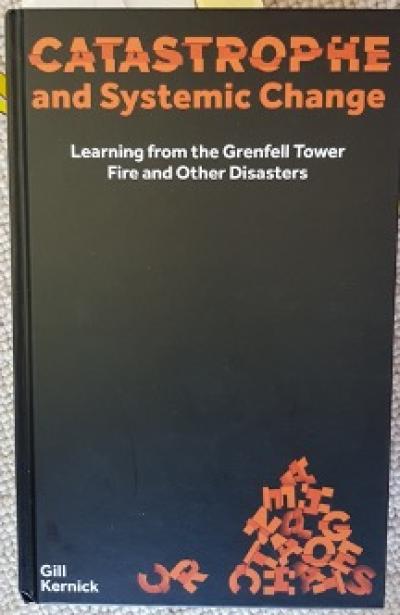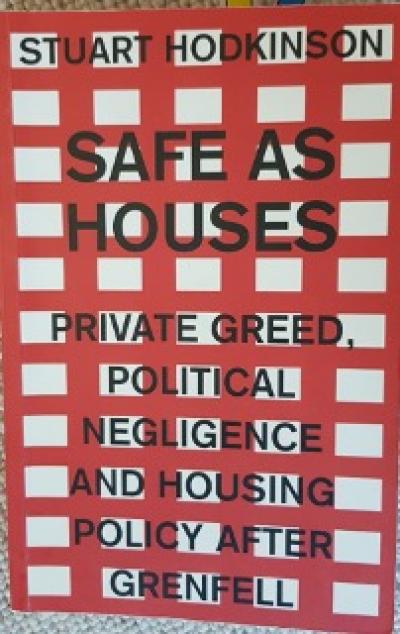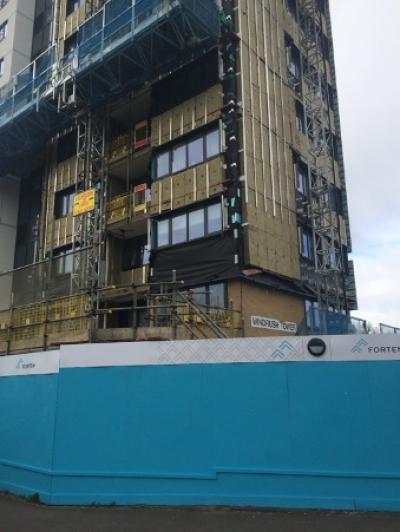Renovations and Complexity: Environmental Goals and Fire Safety
This post considers the role of energy and climate targets in refurbishment projects involving high-rise council blocks.
Posted:
Time to read:

In Catastrophe and Systemic Change Gill Kernick cautions against using simple narratives (heroes/villains, p162) to explain complex decisions and behaviours. As she notes, we operate in an increasingly complex world which involves navigating competing interacting elements that are not (always) predictable (p66). Balancing environmental goals and fire safety is complex, particularly in the light of what Robert Jenrick describes as ‘disturbing allegations of serious malpractice by some construction products manufacturers’ made during the Grenfell Tower Inquiry.
Refurbishing Tower Blocks
Grenfell Tower, like many high-rise council blocks from the 1960s and 1970s, was built with reinforced concrete. Most have not worn well and repair has become necessary. Evidence to the Grenfell Tower Inquiry notes that residents had complained about overheating in the summer, lack of heating control in the winter, draughty windows, thermal inefficiency, and traffic noise. The Grenfell refurbishment carried out during 2012-2016 included the installation of new external insulation, ACM cladding, and replacement windows. The Grenfell Tower Inquiry Phase 1 report concluded that the ‘primary cause of the rapid spread of fire … was the use of ACM rainscreen panels with a polyethylene core, to which the use of combustible insulation contributed’ (34.4). Many other councils have also undertaken major refurbishment projects. Five tower blocks at Chalcots Estate were refurbished in 2006. Residents had made similar complaints about conditions to those at Grenfell (Safe as Houses) and, as with Grenfell Tower, the refurbishment included insulation, rain screen cladding and new double glazing, and shared the same contractors, Rydon, and Harley Facades. Although the same ACM cladding was used as at Grenfell Tower, the insulation at Chalcots Estate appears to have been mineral wool insulation. Nine days after the Grenfell Tower fire the Estate was evacuated due to fire safety concerns relating to cladding, and insulation around gas pipes. In Oxford, five tower blocks originally built in the 1960s began refurbishment in 2016. There was new cladding and mineral wool insulation. Since completing the project the (new) cladding on 3 blocks has had to be replaced due to fire safety issues.

These major refurbishment projects are expensive. At Grenfell the decision to refurbish was in part prompted by some £6 million in capital receipts from property sales becoming available. The Chalcots Estate project was funded through a Private Finance Initiative, and the Oxford project followed changes to the financing of local authority housing stock which enabled OCC to borrow significant sums. Major refurbishment is partially driven by disrepair, but regeneration and visual appearance may sometimes explain the choice of which blocks to renovate, and/or the scope of works. A key goal of the Oxford project was to make the towers look better. The planning application stated that ‘‘the development will improve the visual appearance of the building[s] in nearby and intermediate views’, yet the concerns of residents were not prioritised. Likewise, in relation to Grenfell Tower, the Housing and Regeneration Manger remarked that cladding would help prevent it looking ‘like a poor cousin to the brand new facility being developed next door’. Once selected, environmental aspirations are also key to decisions. In Oxford, there were ‘ambitious’ regeneration and environmental aims.
Environmental Goals
Buildings contribute around 40% of the UK’s total carbon footprint. The environmental impact will be influenced by various features, including the thermal efficiency of the building envelope, embodied carbon within products used, and energy systems. Recognising that the building sector provides great potential for energy savings, the European Union has major ambitions for refurbishing existing housing stock in order to reach energy saving targets. The 2010 EU Energy Performance of Buildings Directive (current version) emphasises the need for deep renovation of building stock, particularly for the worst performing segments, energy-poor consumers, and social housing. This has influenced UK policy. As one of three limbs to its ‘overarching approach to energy efficient renovation’ (p73) the UK’s National Energy Efficiency Plan 2014 incorporated the principle of ‘making buildings more thermally efficient through better insulation and improved airtightness’. The Decent Homes Standard which sets minimum requirements for social housing in England includes a requirement for ‘reasonably modern’ insulation (p77).
These concerns filter down to local level decision making. Retrofitting existing housing stock to improve energy efficiency was part of the London Housing Strategy. RBKC’s Carbon Management Plan 2009 talks of ‘going into battle in the war on climate change’, with plans for ‘better insulation, improved energy efficiency’. Building Regulations contain environmental targets when significant renovations are undertaken: where existing U-values are more than 0.7 W/m2.K ‘reasonable provision’ should be made to limit heat loss through walls, and there are target U-values (0.3 W/m2.K or lower). According to the Sustainability and Energy Statement for the Grenfell Tower project produced by Max Fordham (building services consulting engineering practice) the pre-existing U-value of the concrete tower was 1.5. The target was an aspirational 0.15, better (lower) than that required by Building Regulations. There may be additional drivers, beyond these regulatory requirements. The Sustainability and Energy Statement also refers to the intention in RBKC’s policy on climate change to make a significant contribution to meeting the [then] Government’s CO2 emission reduction targets, and that renovations should achieve specified (’Very Good’) BREEAM standards. Andrew Chapman says ‘limited combustibility’ mineral wool products would have met the required Building Regulation U-values but not the values required to achieve the ‘maximum number of BREEAM credits’. The opening statement for the BSR Team 1 in Phase 2 of the GT Inquiry claims that it was ‘imperative’ to get a BREEAM award, and the ability to secure green (ECO) funding formed part of contract arrangements with the contractor Rydon. Evidence to the Inquiry states, however, that BREEAM targets were not in fact determinant in Max Fordham’s decision-making since decisions about U-values were made before they knew that a BREEAM score would be needed.

Oxford Tower Block
Original Photo by Susan Bright
Aspirational energy and climate change targets seem to have impacted on material and design choices made. Two types of insulation were used at Grenfell Tower, Celotex RS5000 and Kingspan 15, both plastics based and combustible. Mineral wool insulation, with limited combustibility, would need to be thicker than the Celotex or Kingspan products to achieve the same U-value, and this may have presented buildability and aesthetic issues (although calculations supplied to the GTI suggest Rockwool may actually have been possible within the design 69-77). The Chalcots Estate and Oxford projects used mineral wool. Indeed, the contractor at Oxford, interviewed as part of a research project, stated that they were ‘using mineral wools, because of fire regulations, to prevent the spread of flames up the building. You won’t get them to sign off anything involving polystyrene, for anything over 18 metres in height.’ RBKC have admitted to failings in building control. Since Grenfell fire, mineral wool insulation, even though non-combustible (as defined in the Approved Documents), has been said not to meet building regulations if used with ACM.
Whether particular products achieve the environmental claims made for them is highly contested. For example, the focus on U-values takes no account of embodied energy and life cycle costs, and there is recognised to be a performance gap between as-designed and as built retrofit (see also literature review). In addition to the environmental values, product choices will also be influenced by cost, ease to work with, supply chains and marketing. It was changes to the official guidance (Approved Document B) in 2006, supported by a lobbying group set up to represent the interests of the plastic insulation industry, that enabled combustible insulation to be used in cladding systems on high-rise buildings subject to passing a BS8414 test.
Complexity
Phase 2 of the Grenfell Tower Inquiry is currently investigating the decisions that led to the installation of the particular cladding system there. The opening statement of the BSR Team 1 for Phase 2 claims that there was a desire to offset project costs through acquiring ECO funding. The statement continues: “The over focus on sustainability, an ostensibly laudable aim, but in this case driven in large measure by a desire for funding, literally fuelled the inferno which ensued.” The Inquiry is uncovering terrible failings in testing regimes, and revealing that various people in the chains of supply and construction knew of, or closed their minds to, fire risk. The cladding and insulation choices made at Grenfell Tower both caused the terrible fire spread and the production of dense and lethal smoke conditions. Some of these decisions were driven by cost cutting measures: when the original zinc cladding was switched to ACM little thought was given to fire safety. The uncertain regulatory context post-Grenfell, and budgetary constraints, means new projects have been postponed. Going forward, it is vital that the environmental and fire safety claims of products and construction practices are robustly examined to ensure that renovation of existing housing stock is both environmentally efficient and safe.
Sue would like to thank Gill Kernick, Andrew Chapman and Tom Woolley for feedback on earlier versions.
--
How to cite this blogpost (Harvard style)
Bright, S. (2021) Renovations and Complexity: Environmental Goals and Fire Safety. Available at: https://www.law.ox.ac.uk/housing-after-grenfell/blog/2021/08/renovations-and-complexity-environmental-goals-and-fire-safety (Accessed [date])
Share:
